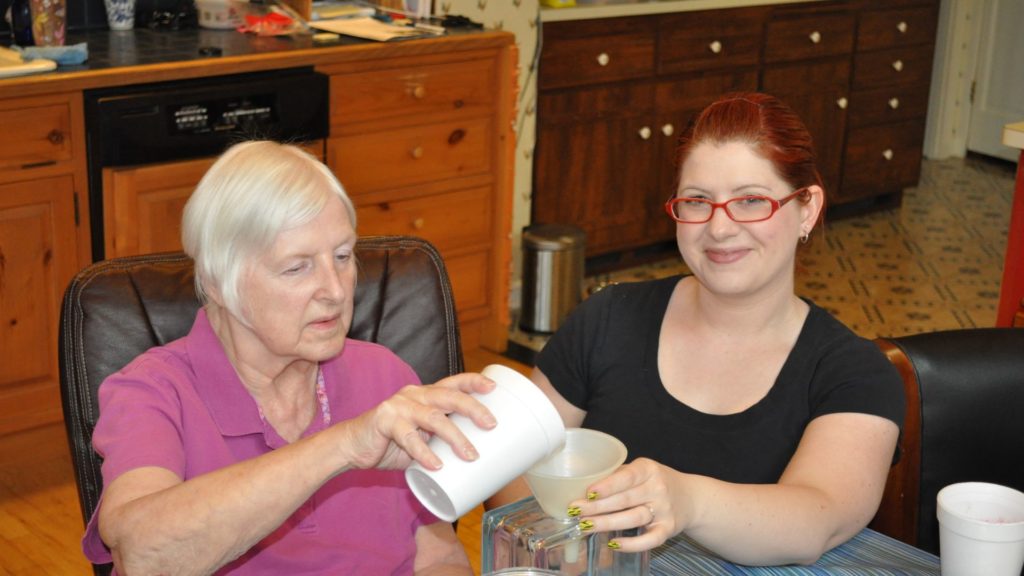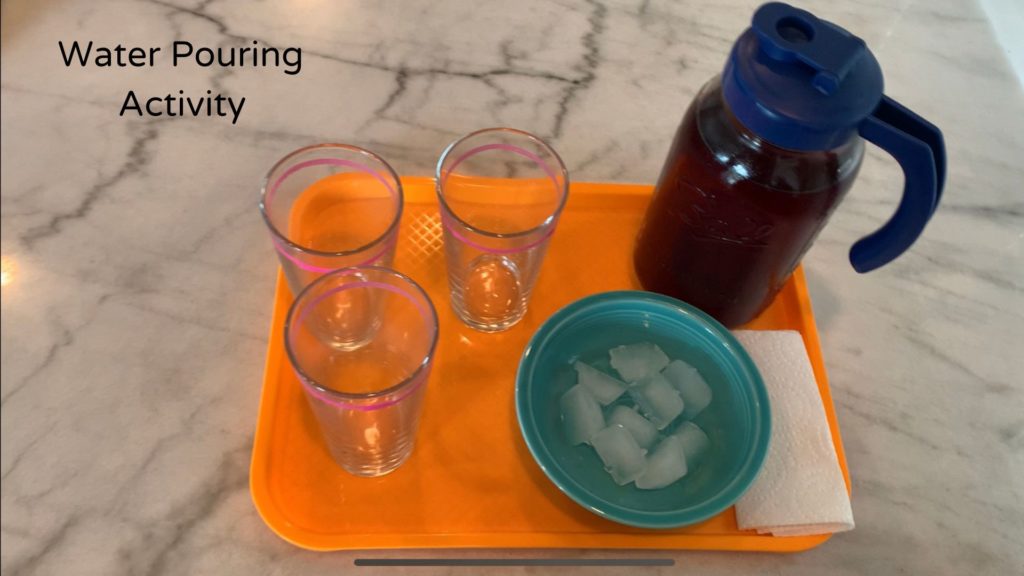Activities help decrease challenging behaviors in dementia, but they need to be set up in a way that people with dementia know to use them. Too often we just put out an activity, or keep things on a shelf in another room, or wait for our loved one to ask to do something, but in Montessori we prepare the environment so that they are drawn to do activities on their own.
However, we do not live in a classroom, so how do we set up activities in a way that flow with our everyday life and help our loved one?
Key Points:
- The brain feels anxious and overwhelmed when it has nothing to do, or it does not have clear cues as to what it should be doing, so activities can help decrease wandering, confusion, and rummaging.
- Activities need to be placed in a visible spot to cue the brain to engage with them.
- Activities should be placed in the same spots every day to help the brain know where to find them.
- Invitation and sequencing signs are a great memory aid to help people know to do the activity.
- Your house does not need a major revamp, just a few pieces of furniture and a place to store activities you are not using.
Why Activities Matter
Dr. Montessori observed that children have 11 human tendencies. These tendencies are things that humans do that allow them to adapt and survive in the larger world and social community. One of these tendencies is work. In dementia care, instead of work, we talk about meaningful activities.
Work is a human tendency, because work allows us to get things done and enables us to do the things that keep us safe, such as, in our ancestral past, hunt, gather, prepare food, and care for family. What we now know about the neurology of how our brain works is that work is not only essential to physically survive, but our brain needs it.
Without any meaningful work/activity, the brain can get anxious because it has nothing to focus on. The brain does not like to literally have nothing to do and no guidance of what it should be doing. That then triggers the amygdala (fear center of the brain) and we have behaviors such as anger, confusion, wandering, and becoming obsessive about things.
This is true for all of us, not just children. And, it holds true for people with dementia as well.
We all need breaks, but having not enough to do for too long is a problem. And, of course, too much work can be overwhelming, so we want to find the right amount for the person we are working with.
We also want to set up activities so that they are accessible and the person with dementia is cued to use them.
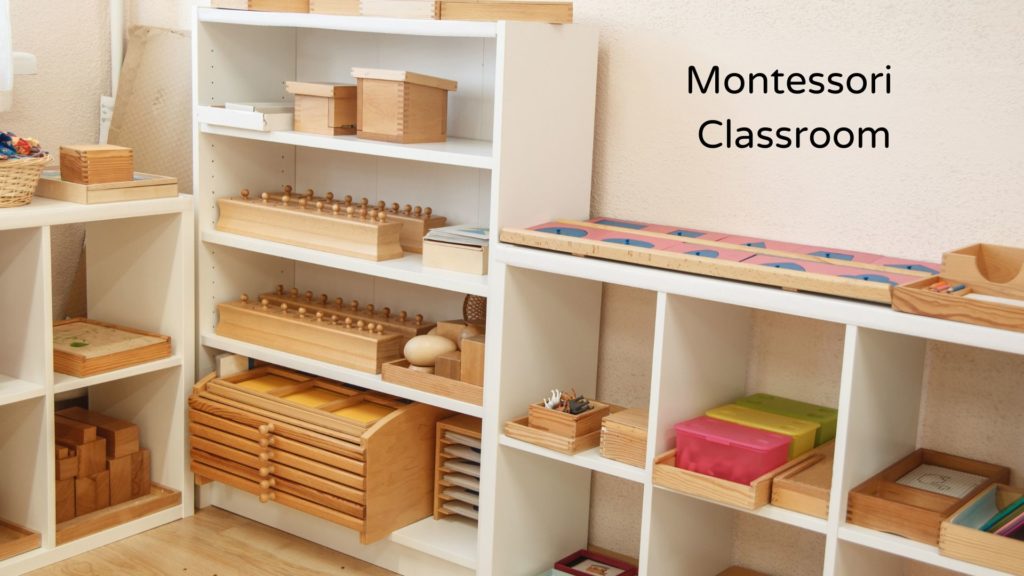
In a Montessori classroom and dementia environment, activities (work) is put out in the person’s line of sight so that people can see the options available and choose what interests them.
However, this can be difficult in the home environment because we are trying to keep a balance of everyone being able to use the house, putting activities in a place people can see and access them and that remain consistent, and also not creating too much clutter or change to the environment that is disorienting for our loved one with dementia.
To make the process easier, I have put together six tips to setting up activities in the home.
Tips For Setting Up Activities in The Home
1. Set Up a Dedicated Activity Table
It is helpful to have at least one activity area that is a place where your loved one can sit and do an activity. You don’t want to have to take activities in and out of cupboards all the time or off shelves if they struggle to carry a tray and walk to the table with it. It is helpful for time and accessibility to have a place where we can have an activity set up and ready for our loved one to use it.
Setting up a designated spot early on in the journey with dementia is helpful later because the table will become a cue to the brain that they will be doing an activity. Also, since the activities done there have been set up to be accessible, they will associate activities done in this area with success and this can help decrease resistance to doing an activity for fear of not knowing how to do it.
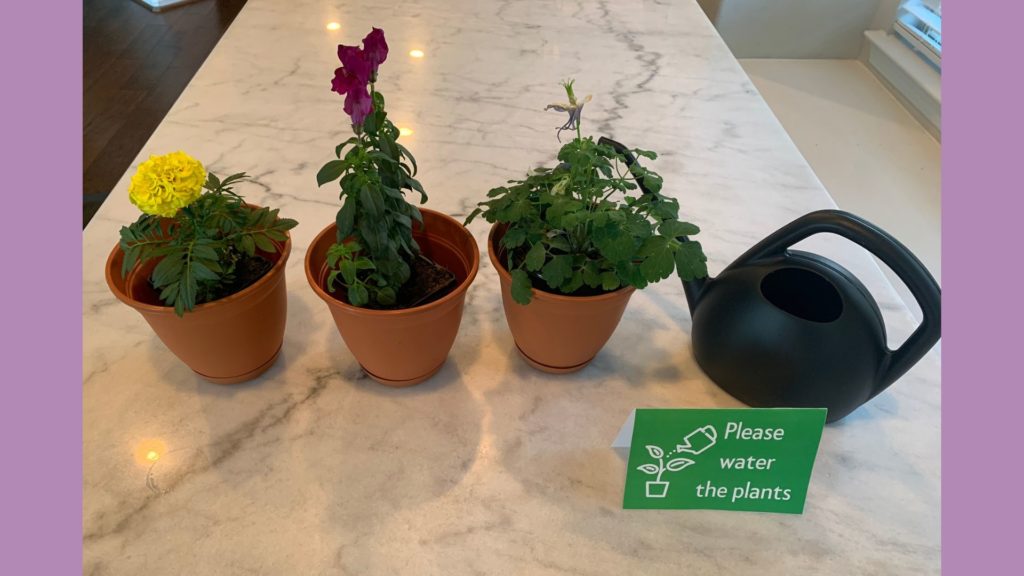
2. Place Activities Within Eyesight
In Montessori classrooms, work is put on shelving that is often lower to the ground in younger classrooms, but higher as children get older and taller. Work is also placed based on areas, such as all practical life areas where children will work on washing dishes, folding clothing, and pouring will be in one area, whereas language work such as three part cards will be in another area.
While normally we want to try and keep activities in an area where the brain would know to do them, such as a water station in the kitchen, many people with dementia have mobility issues and tend to live more in one area of the house. If this is the case for your loved one, you may need to put activities such as folding napkins for dinner, within their eyesight of where they spend the most time, which might be the living room.
Remember, seeing things is a visual cue, a type of memory aid, so lean more towards setting up activities within eyesight even if they do not always fit the original purpose of the room they are in.
However, do try to keep similarly themed activities together. For example, if you set up a reading area with a sign that says “Please read a book,” you may not want to put a woodworking activity at that same table.
3. Use Signage With the Activity
Signage triggers a person to do a task, it cues procedural memory, and it supports the ability to sequence a task in order so that you can complete the activity. For activities in the home, in earlier stages of dementia, an invitation sigh may be all you need. This type of sign invites someone to do an activity, such as “Please water the plants.” You would place this next to the plants and a watering can that is already filled for them.
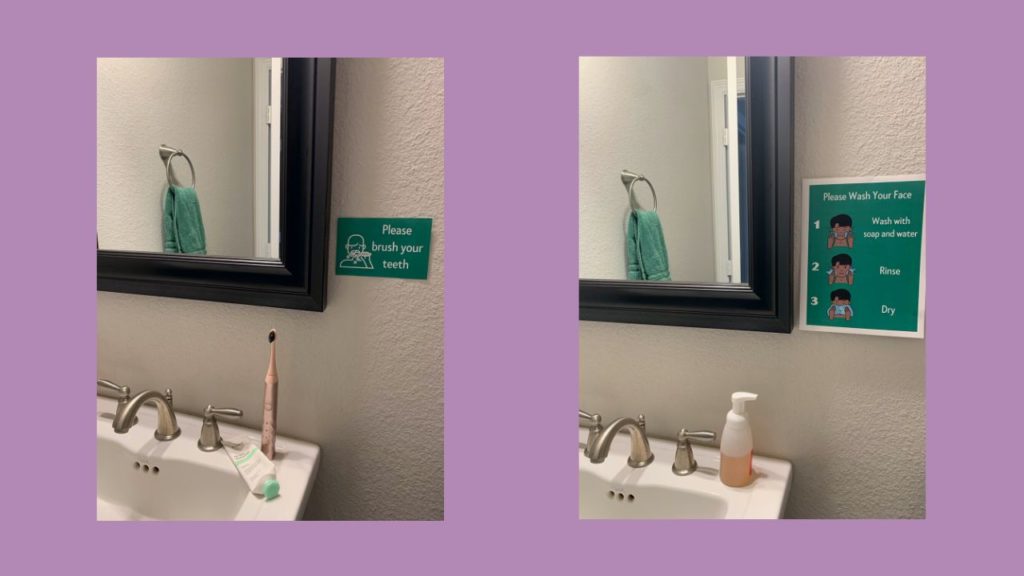
For mid-stage, you may want a sequencing sign, which is a sign that shows the steps needed to complete an activity. These have the invitation at the top, followed by the steps, such as “Please fold the napkins” and then 3-5 steps (often with pictures) showing how to complete the activity.
There is also a type of signage you can use for yourself if your loved one needs one-to-one guidance to complete an activity, and this is what I call the “Montessori recipe.” This is your step-by-step guide that shows you or someone visiting or a hired caregiver how to guide your loved one through the activity. My signature Montessori recipes are what you will find in the back of my book, Creative Connections in Dementia Care® and included in any activities I create, such as in my Three Part Cards activities packs.
4. Balance Clutter and Change
We often tell you that clutter is distracting to people with dementia, which is why we set up activities in a very specific way, with only the items needed for that activity, and sometimes only the items needed for one step of the activity.
This is why a designated area to complete activities is helpful, so that all other items can be removed.
However, some people actually have always lived with their items all around them, especially if they have ADHD or Executive Functioning Disorder, or they are a more creative personality type. They like to be able to see their things. If we start to put away all of their things and only put out items for activities, this can make them agitated, wondering where their items are. This is another reason why the designated table for activities can be helpful- that area is designed to be uncluttered and only for activities, whereas other areas of the house, maybe where they sit and read or draw, has more of their beloved items around them.
You also want to be careful about just totally revamping the house and putting up shelves with a few activities, signage on the cabinets, and an activities table- this can look like too much change to their environment and can cause confusion. Try and make the activities fit into the space and don’t introduce too many new things at one a time.
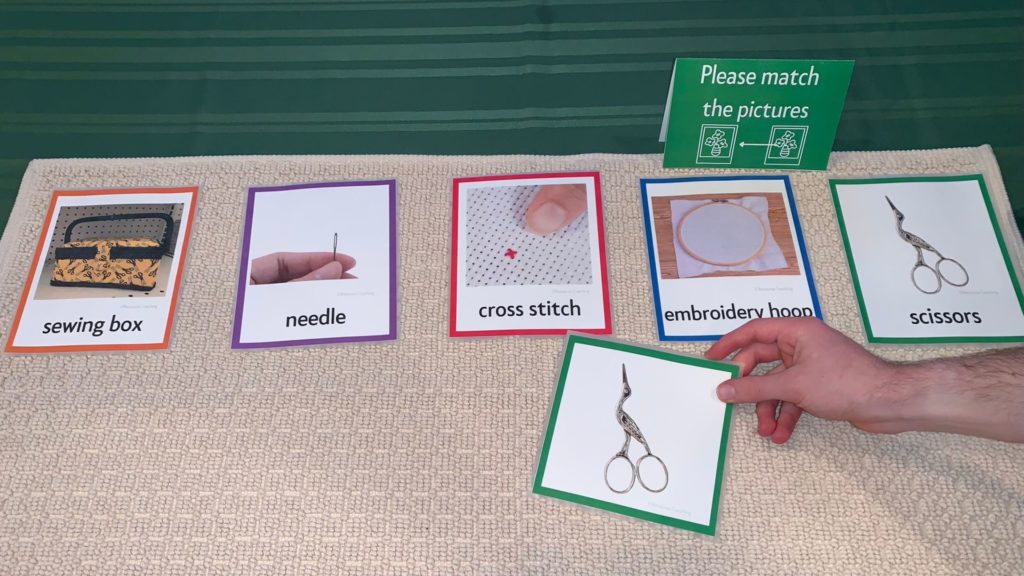
5. Remember, All of Life is an Activity
Everything we do is an activity, so when looking at the home environment, think about where is a natural place to set up an activity. Here are some examples:
- Set up their toothbrush, toothpaste, and floss in the same area at the bathroom sink every day.
- Rather than just leaving books on a big bookshelf, take a few down at a time and place them on a side table so that they are easier to see and more of a memory aid to pick up a book and read.
- Set up a makeup station for them in the bathroom, with just the essentials and maybe 1-2 lipstick and eyeshadows to choose from. You can rotate these choices daily.
- Setting the table, folding napkins, sorting utensils, those can be set up at the kitchen table or countertop.
- For people who like to sort receipts or pay bills, set up a station for them in their office or wherever it is natural for them to have done these tasks in the past.
- Set up a water pouring station in the room they spend the most time in. Or, if they are in early stages, then set up a pitcher and some glasses on the kitchen countertop.
6. Have a Storage Area for Activities
You don’t want to have to go finding sets of activities all over the house when you need them. You want to be able to get an activity tray and put it out. So, find a place where you can keep activities that you rotate out or use at different times of the day. Place the activities in labeled clear storage boxes so you can just grab the activity and put it on a tray with a mat. Keep your trays and mats in your storage area.
Do I Need to Buy Shelving?
Setting up these activities does not need to look like a Montessori classroom. Let’s look at the simplest options for furniture.
- Have a table with good seating (accessible for them) that has enough room for your loved one and someone to sit with them when they need a guide. Set out an activity for them so that they can just sit down and do it. Such as a sign that says “Please play solitaire” with the cards already laid out for them.
- A sideboard, which is usually a thinner piece of furniture that goes up against a wall, is about waist height, and has at least one shelf can be a great addition to the home and a place to put a few trays of activities. This way they are visible, enticing, and inviting for the person to choose something off the sideboard to take over to the table and use.
- One section of shelving that is at waist height where they can take items off of it can be helpful.
- A cabinet or use an existing closet, for you to store the activities, trays, and mats in.
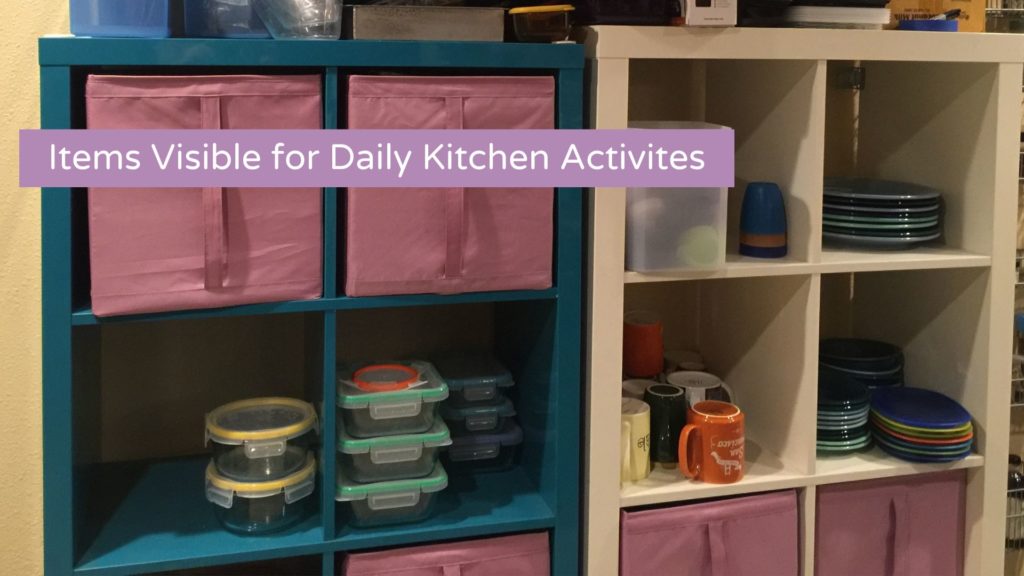
Making Activities in the Home Easier
Over time, you will find the right balance of how many activities to have out at any one time, where they should be placed, and what types of signage you may need (if any) to help your loved one with dementia use the activities.
It may take a little time in the beginning, but once you find what works, just imagine how your loved one will feel in their space! They will be drawn to activities that they enjoy and that give them a sense of personal agency, accomplishment, and joy. They will be able to work on things while you are able to do the things you need to do, or take a break, or read a book, or just take a breath and not feel so on edge being on-call all the time.
I hope this article helps make the idea of implementing activities less overwhelming and more doable. If you have questions about your situation and need help knowing what activities will work for your loved one and how they need to be set up for them, I would be happy to help you. You can sign up for one-on-one dementia care coaching with me at my website, Recourse Coaching.

